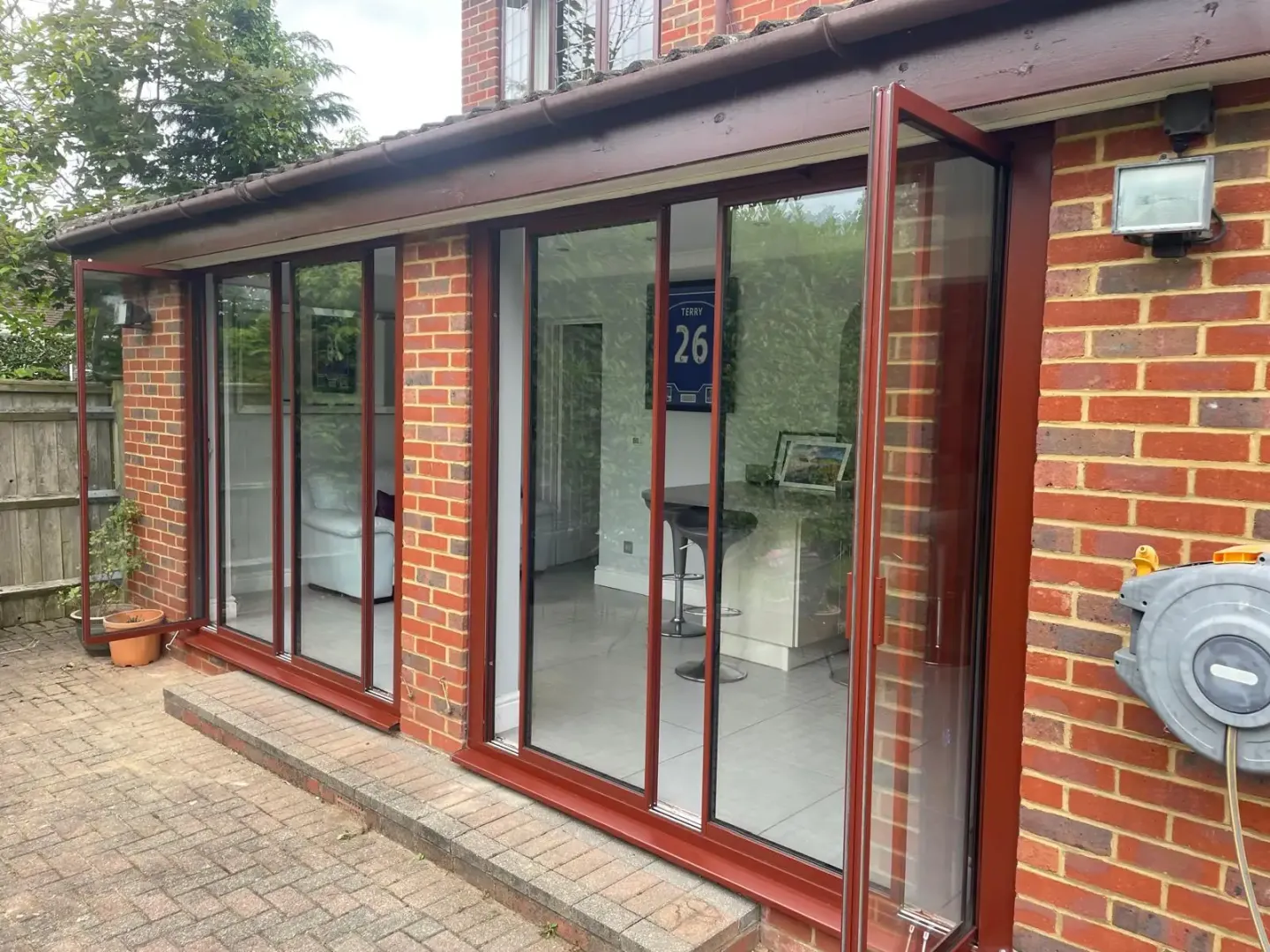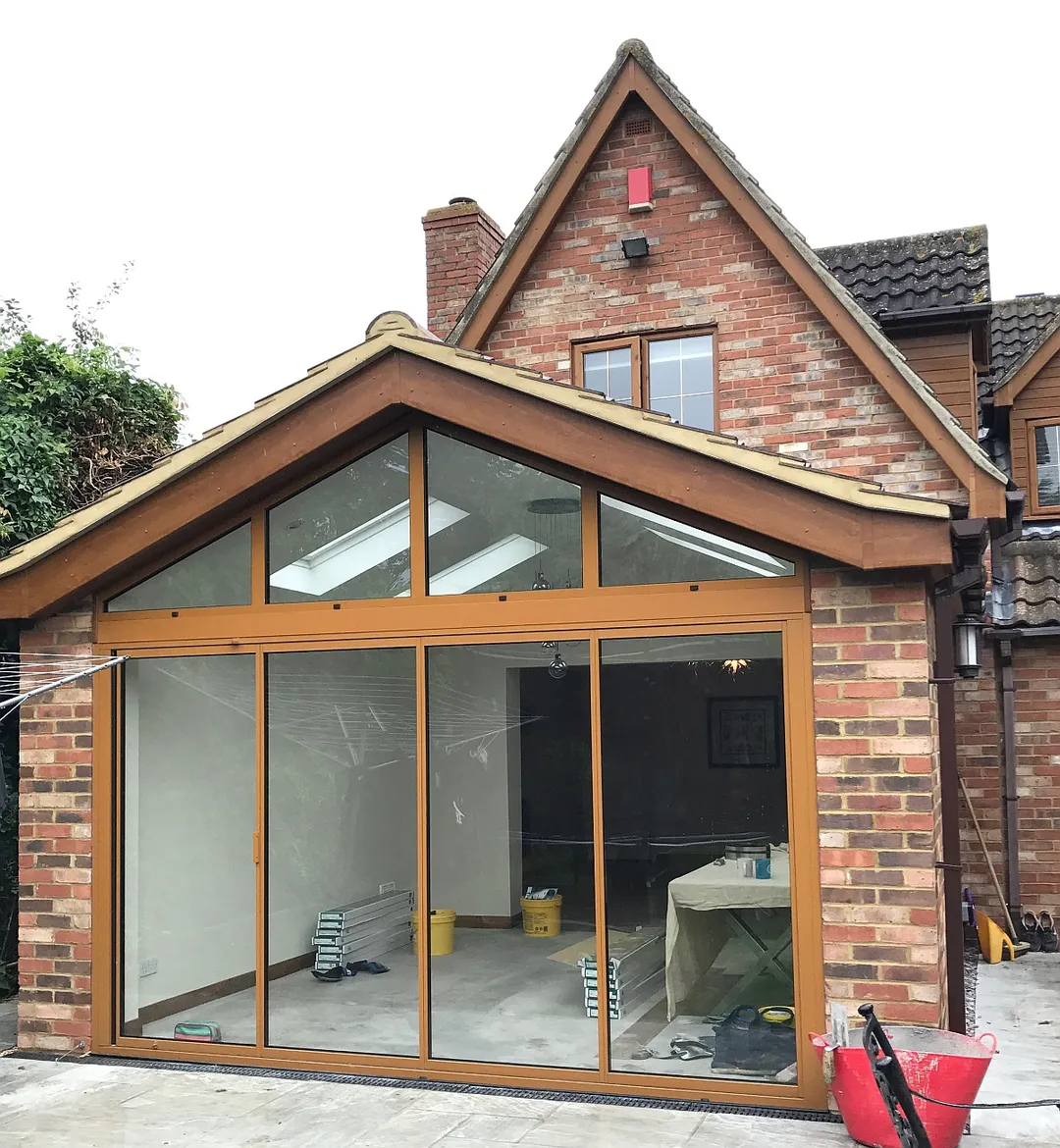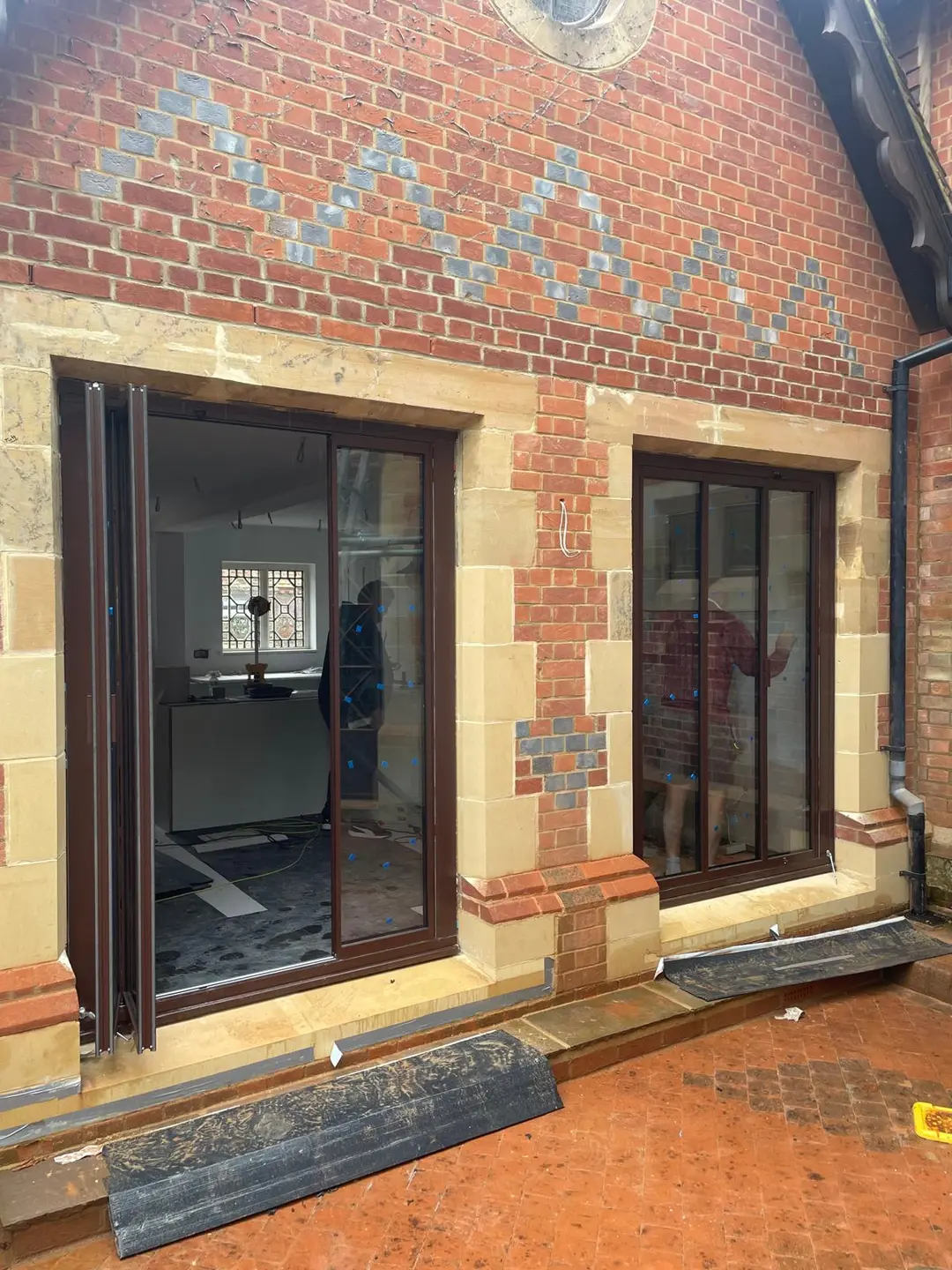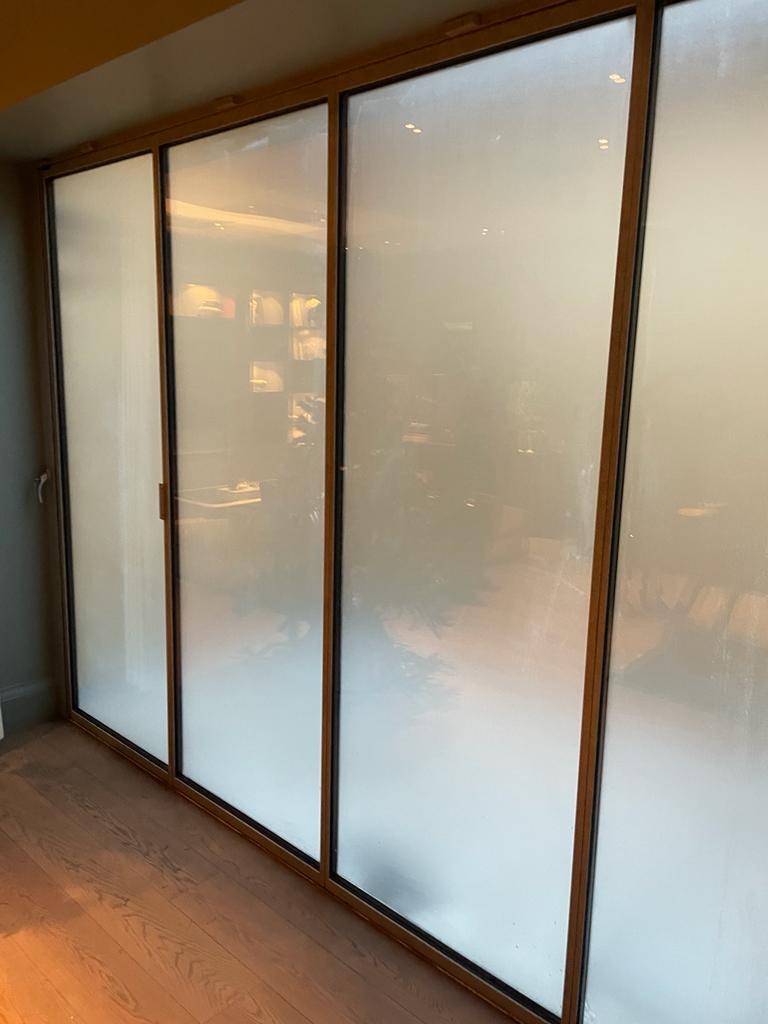Brown Patio Doors Design and Style Guide
Table of Contents

Brown patio doors strike a perfect balance between traditional charm and modern practicality in British homes. Moving away from stark whites and modern greys, these doors bring natural warmth to living spaces while maintaining clean lines and functionality.
What Makes Brown Patio Doors Different
Brown doors stand apart from their counterparts through a unique mix of practical benefits and visual appeal. Rather than drawing attention like black frames or disappearing like white ones, brown patio doors create subtle depth that works brilliantly with British architectural styles.
Natural Light Benefits
Soft brown tones filter daylight differently than other frame colours. Where darker frames can create harsh shadows, brown patio doors help diffuse sunlight more gently into your room. This subtle filtering creates a warmer atmosphere throughout the day, particularly in north-facing rooms that receive less direct sunlight.

Visual Weight and Balance
Brown sliding doors achieve something quite special in terms of visual weight. The colour naturally draws the eye without overpowering the view beyond, creating a smooth connection between your interior and garden. This middle-ground approach means brown doors work especially well in period properties where black frames might look too contemporary and white too clinical.
An interesting quirk of brown exterior patio doors lies in how they affect our perception of frame thickness. The natural depth of brown tones can make frames appear slimmer than they actually are, especially when viewed against brick or stone. Glass doors in brown finishes often look more refined than the same design in lighter shades, as the colour helps disguise the frame’s true dimensions.
Colour Psychology
Beyond pure aesthetics, brown doors tap into our instinctive response to natural materials. This popular choice stems from the colour’s ability to promote feelings of stability and groundedness – qualities particularly valued in British home design. The rich, earthy quality of brown creates a more intimate connection with outdoor spaces than artificial-looking whites or ultra-modern blacks.
Choosing the Right Shade of Brown
Picking the perfect brown for your patio doors takes more thought than you might expect. Brown comes in countless variations, each bringing its own character to your home. While pure black or white leave little room for creativity, brown patio doors open up a spectrum of possibilities.

Light Oak to Rich Walnut
Nature provides the best inspiration for brown door finishes. The lightest shades mirror the honey tones of freshly cut oak, creating a bright, airy feel that works beautifully in modern homes. Moving through the spectrum, you’ll find mid-tones that capture the warmth of cedar or teak. At the darker end, rich walnut and mahogany-inspired browns give brown sliding doors a more formal, sophisticated appearance.
The same brown shade can look remarkably different depending on your chosen material. Glass patio doors with textured aluminium frames tend to reflect more light, making browns appear slightly lighter than their swatches suggest. In contrast, woodgrain finishes absorb more light, often making the same colour look deeper and richer.
Popular Brown Door Colours
Modern brown patio doors come in several distinct families of shades. Here’s what you’ll typically find:
- Golden Oak – A light, warm tone
- Rosewood – Rich red undertones
- Irish Oak – Grey undertones
- Walnut – Deep chocolate notes
- Bronze – Metallic undertones
Each of these creates a distinct mood. Take garden room sliding doors as an example – golden oak brings a bright, summery feel, while bronze adds industrial character to the space. Double doors in deeper walnut tones create a more traditional look, particularly suited to period properties.
Regional Architecture Matching
British architecture varies widely by region, and brown patio doors should complement these local styles. Homes in the Cotswolds often suit lighter, honeyed browns that echo local stonework. Meanwhile, Victorian terraces in northern cities might benefit from deeper browns that harmonise with their red brick facades.
Different regions also receive varying amounts of natural light. Northern areas might benefit from lighter browns to help brighten spaces, while southern homes can handle darker shades without feeling gloomy. This wide range of shades means you can find browns that work perfectly with your specific location and architecture.
The quality of natural light changes with latitude too. Scottish homes experience longer periods of low-angle sunlight, making lighter browns particularly effective at capturing and reflecting available light. Coastal properties often suit mid-tones that stand up well to bright reflections off water and resist showing salt spray marks.
Customised solutions allow you to match your doors precisely to existing woodwork or architectural features. You might choose to match the exact shade of original Victorian woodwork or pick up subtle undertones in your stone cladding. Whatever your home’s character, there’s a brown that will work perfectly.
Brown Sliding Doors for Period Homes
Older properties present unique challenges when choosing new doors. Brown sliding doors offer a way to add modern convenience while staying true to traditional architecture. The right shade creates visual harmony between contemporary glass and heritage features.
Traditional Brick Houses
Victorian and Edwardian brick homes often feature deep, rich woodwork. Brown patio doors in darker shades like rosewood or walnut echo these original features while introducing more light than traditional external doors. The combination of modern thermal glass and period-appropriate frames gives you the best of both worlds.
The red and orange undertones found in many British bricks work particularly well with copper-brown door frames. These warmer browns pick up the natural variations in the brickwork, creating a cohesive look that appears as though the brown patio doors were part of the original design.
Original period features like stone lintels and brick arches remain important focal points. Brown patio doors shouldn’t compete with these elements but rather complement them. Choosing frames with traditional proportions and appropriate brown finishes helps maintain the integrity of your period property.
Stone Cottages
Natural stone buildings demand careful colour selection. Brown door designs that mirror aged timber work exceptionally well here. Lighter, greyed browns reminiscent of weathered oak create a natural partnership with limestone or sandstone walls.
The varied tones found in stone walls provide excellent inspiration for exterior doors. Brown patio doors can pick up the subtle honey or ash tones present in the stonework. This attention to detail helps new doors settle naturally into centuries-old architecture.

Victorian and Edwardian
These eras celebrated craftsmanship and natural materials. Deep espresso-toned frames pay homage to this heritage while offering modern performance. When choosing the best patio doors for Victorian homes, look for browns with subtle grain patterns that suggest hand-finished timber.
Bay windows and decorative brickwork characterised these periods. Brown patio doors should work with these features rather than against them. Deeper browns create strong vertical lines that complement typical Victorian proportions, while maintaining the formal character these properties deserve.
Original Victorian and Edwardian homes often featured dark-stained wooden windows and doors. Modern brown patio doors can recreate this traditional appearance without the high maintenance requirements of actual timber. The key lies in selecting browns with the right depth and richness to mirror historic finishes.
Brown Patio Doors in Modern Settings
Modern architecture often favours stark minimalism, but brown patio doors bring necessary warmth without compromising clean lines. Their natural tones create visual interest while maintaining the simplicity that contemporary design demands.
Minimalist Schemes
White walls and concrete surfaces dominate many modern homes. Brown aluminium patio doors break up these clinical spaces, adding depth without disrupting architectural purity. Warm chestnut tones work particularly well against raw materials like exposed concrete or steel, softening their industrial edge.
The key to modern minimalism lies in subtle detail. Wide sliding doors in rich browns create striking horizontal lines that draw the eye across a space. Rather than interrupting the clean aesthetic, these linear elements become part of the architectural language.
Frame Proportions
Modern external patio doors often feature slimmer frames than their traditional counterparts. In brown finishes, these slim profiles appear even more refined. The visual weight of darker browns allows for incredibly thin frames while maintaining presence – something harder to achieve with lighter colours.
Coastal Homes
Seaside properties face unique challenges. Salt spray and intense sunlight can quickly age poorly chosen finishes, but brown patio doors in modern finishes stand up remarkably well to coastal conditions. Lighter woodgrain browns mirror the colours of driftwood and weathered timber, fitting naturally into beachside settings.
Natural light behaves differently by the coast. The intense reflection from water and sand means browns need careful selection. Mid-tones often work best here – dark enough to provide definition but light enough to prevent heat absorption on sunny days.
Coastal architecture tends toward white and blue colour schemes. Brown sliding doors provide welcome contrast without feeling heavy or dark. Their warm tones balance the cool coastal palette while maintaining the bright, airy feel essential to seaside living.
Urban Spaces
City homes must balance privacy with light. Deep chocolate-toned frames strike this balance perfectly, defining spaces without creating barriers. In urban settings, brown patio doors often serve as room dividers as well as external doors, their rich tones helping to zone open-plan spaces.
High-rise apartments benefit from brown’s ability to ground spaces. Floor-to-ceiling glass can feel exposing, but dark brown frames provide reassuring structure. The earthy tones also help connect concrete-and-glass buildings to the ground below, creating visual links to parks and gardens.
Contemporary urban architecture often plays with texture as much as colour. Smooth metal frames in rich browns provide sophisticated contrast against rough brick or textured render. This interplay of surface finishes adds depth to modern facades without relying on bold colours or patterns.
Mixed Material Design
Today’s architects often combine multiple materials in single projects. Brown patio doors excel in these settings, bridging the gap between different elements. They work equally well alongside timber cladding, stone walls, or metal panels, helping unite diverse material palettes.
The latest manufacturing techniques allow for incredibly precise colour matching. This means brown patio doors can perfectly match other architectural elements – from wooden beams to bronze window frames – creating cohesive design schemes across different materials and surfaces.
Modern brown finishes offer unprecedented durability. Unlike traditional wood stains, these colours resist fading and wear, maintaining their appearance despite heavy use. This permanence makes them ideal for contemporary homes where longevity matters as much as immediate visual impact.
Materials and Finishes Guide
The performance of brown patio doors depends heavily on their material composition. Each type brings distinct advantages, from the natural beauty of timber to the precision engineering of aluminium patio doors.
Real Wood vs Alternatives
Natural timber offers unmatched character, with each piece displaying unique grain patterns. However, modern alternatives like brown sliding patio doors in aluminium or uPVC often prove more practical for everyday use. These materials resist warping and require far less upkeeping than wood, while modern finishing techniques recreate timber’s organic appearance.
Raw timber needs regular treatment to maintain its colour and protect against moisture. In contrast, manufactured brown patio doors retain their appearance year after year with minimal intervention. This longevity makes them particularly suitable for busy households or rental properties.
Surface Technology
Recent advances in surface treatments have revolutionised how alternative materials look and feel. Aluminium framed sliding doors now often feature incredibly realistic wood-effect finishes, complete with tactile grain patterns. These surfaces resist scratches and maintain their appearance far longer than traditional wood stains.
Textured Finishes
Modern manufacturing allows for incredibly diverse surface textures in brown door frames. Smooth, matte finishes suit contemporary homes, while textured surfaces mirror the character of natural wood. These variations in texture affect how light plays across the surface, creating subtle depth that changes throughout the day.
The latest powder coating techniques produce extraordinarily durable brown finishes on aluminium frames. Unlike paint, these coatings become part of the metal’s surface, resisting chips and scratches while maintaining rich colour depth. This technology brings unprecedented durability to brown patio doors.
Hardware Pairing
The choice of handles, locks, and other hardware profoundly influences a door’s final appearance. Brushed steel and chrome fittings create modern contrast against brown frames, while bronze or brass hardware adds traditional character. The metal’s finish has an impact on both aesthetics and energy efficiency – quality hardware provides better insulation and smoother operation.
Multi-point locking systems need careful integration to maintain clean lines. Brown sliding doors often feature concealed mechanisms, keeping the focus on their elegant frames rather than visible hardware. This subtle approach maintains visual simplicity while ensuring security.
Hardware selection also impacts daily usability. Lever handles prove easier to operate than knobs, especially on wider doors. The latest systems include soft-close mechanisms and magnetic catches, making brown patio doors notably easier to use than older designs.
Material Performance
Each material responds differently to temperature changes and weather exposure. Aluminium expands and contracts less than uPVC, making it ideal for larger brown patio doors. This stability helps maintain smooth operation regardless of weather conditions.
Modern manufacturing combines different materials to maximise their strengths. Thermal breaks in aluminium frames prevent heat loss, while composite materials offer the best characteristics of multiple components. These innovations mean brown patio doors now offer excellent thermal performance without compromising on appearance.
The weight of different materials affects installation requirements and operation. Aluminium’s strength allows for larger glass panels and slimmer frames than uPVC, while modern rolling mechanisms ensure smooth movement even in substantial doors. This engineering makes today’s brown sliding patio doors notably easier to operate than previous generations.
Brown Patio Doors and Interior Design
The colour of your doors shapes the entire feel of your living space. Brown patio doors work differently with various interior styles, from classic to ultra-modern schemes. Their natural warmth helps create visual connections between different elements of your room design.
Light Walls
Pale plaster and white walls provide an ideal backdrop for brown patio doors. The contrast draws attention to the doors’ clean lines without creating harsh divisions. Cocoa-toned frames add definition to neutral spaces, preventing rooms from feeling flat or washed out.
Light reflectance values play a big part in room dynamics. Tall patio doors in brown bring structure to high-ceilinged spaces, while their frames help guide light deeper into the room. The interplay between pale walls and brown frames creates subtle shadows that add depth throughout the day.
Frame Effects
Types of patio doors vary in their frame thickness and style. Brown aluminium sliding doors typically feature slimmer frames than uPVC alternatives, changing how they interact with wall colours. Thinner frames in dark brown create elegant lines against light walls, while broader frames provide more substantial architectural elements.
Bold Décor
Strong interior colours need careful balancing. Deep espresso frames complement rich wall colours without competing for attention. In rooms with statement furniture or artwork, brown sliding doors provide a sophisticated backdrop that doesn’t overwhelm the space.
Pattern and texture interactions require thoughtful planning. Woodgrain finishes in brown patio doors can either complement or contrast with patterned wallpaper and textiles. The key lies in matching the door’s finish to your room’s overall texture palette – smooth frames suit sleek modern furnishings, while textured finishes work better with natural materials.
Monochrome Spaces
Black and white schemes benefit from brown’s moderating influence. Rather than stark contrasts, brown patio doors introduce subtle gradients that soften monochrome interiors. Their natural tones prevent spaces from feeling too clinical or severe.
Modern minimalist designs often incorporate brown to add warmth without compromising simplicity. The organic quality of brown frames helps connect stark architectural elements, making spaces feel more welcoming without sacrificing their clean lines.
Brown frames work particularly well in monochrome kitchens, where they echo wooden worktops or furniture. This connection helps unite different zones in open-plan spaces, letting the doors become part of the room’s architecture rather than standing apart from it.

Lighting Design
Natural and artificial light interact differently with brown frames throughout the day. Morning sun brings out warm undertones, while evening light emphasises deeper shades. This variation adds subtle dynamism to your space as light conditions change.
Spotlights and downlighters near brown patio doors create interesting shadow effects. The frames cast clean lines across floors and walls, adding architectural interest through light play. Careful positioning of light sources can highlight the doors’ construction while avoiding unwanted reflections.
Seasonal light changes affect how brown tones appear. Winter sun at low angles creates different effects compared to summer’s higher light, making brown frames an engaging element in your room’s year-round design. The natural variation keeps spaces interesting without requiring any alterations.
We’d Love to Help You
Vision Glass Doors is a designer, manufacturer, and installer of premium door systems. We are a family run business with over 20 years’ experience and 5,000 installations across the UK.
Our leading range of door systems include Ultra Slim – Slide and Turn Doors, Slimline Sliding Patio Doors and Frameless Glass Doors. Suitable for various internal and external applications, they are applicable to residential and commercial projects.
Click Quick Quote Online for a free quotation within 24 hours. Alternatively, call or email us on 01582 492730 or at info@visionglassdoors.co.uk.

